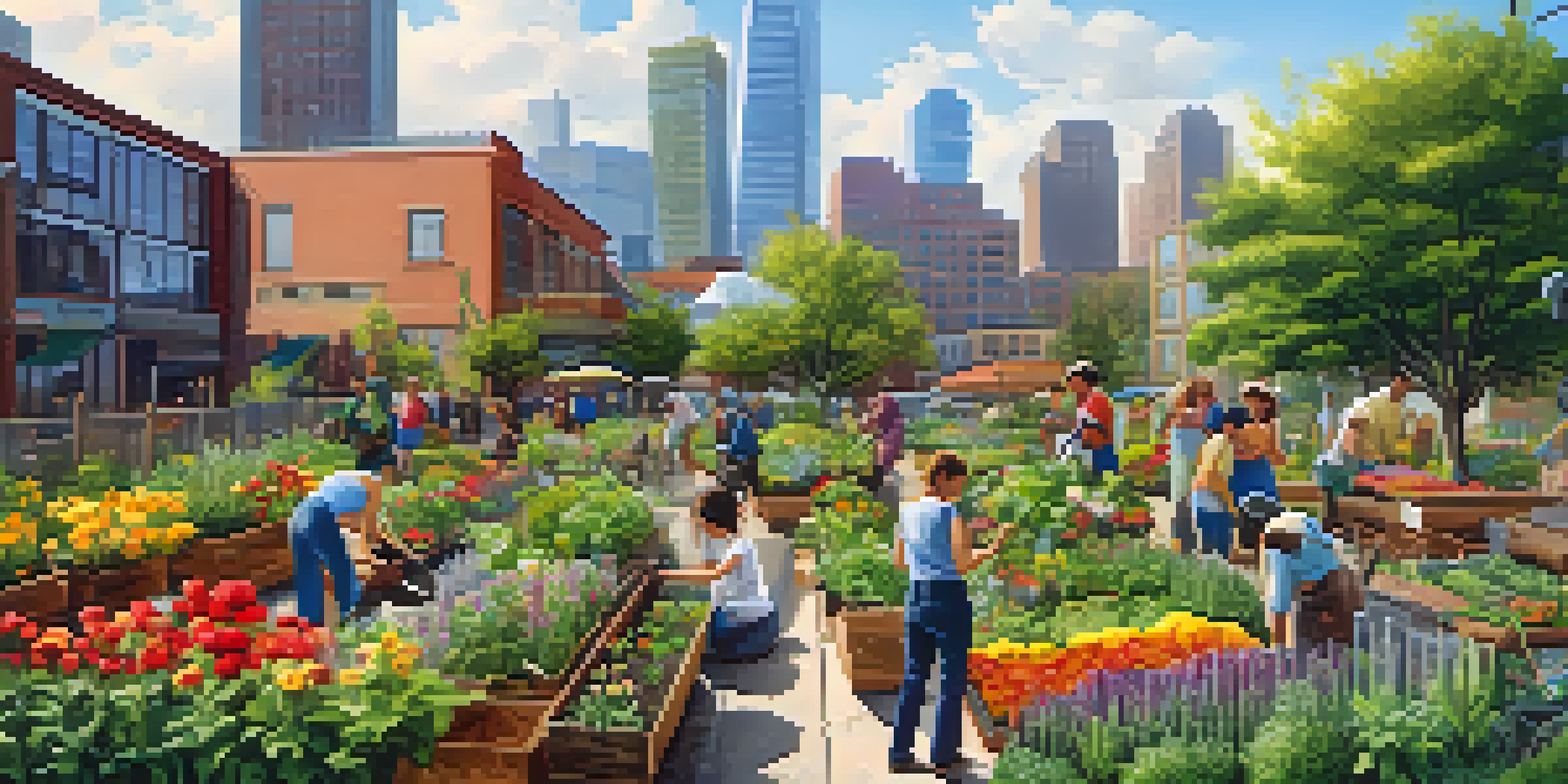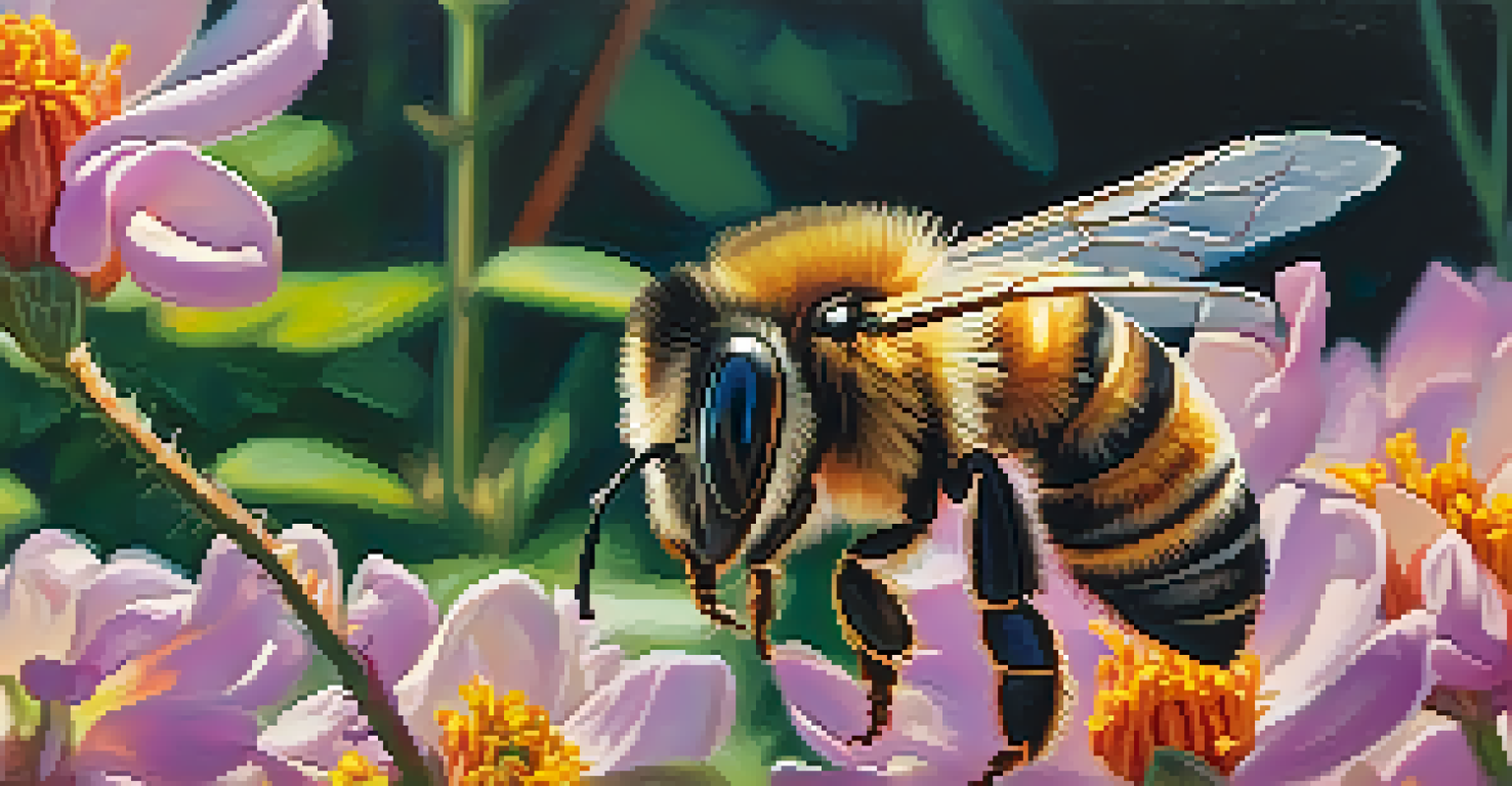Community Gardens: Promoting Biodiversity in Urban Areas

Understanding Biodiversity and Its Importance
Biodiversity refers to the variety of life in a particular habitat or ecosystem. In urban areas, this diversity is crucial as it supports ecosystem health and resilience. By promoting biodiversity, we help maintain natural processes like pollination, pest control, and nutrient cycling.
Biodiversity is the foundation of ecosystem services, upon which we all depend.
A rich biodiversity creates a balanced urban ecosystem, which can improve air and water quality. It also provides habitats for various species, from insects to birds, which are essential for a thriving environment. The presence of diverse flora and fauna can enhance the beauty of our cities, making them more enjoyable places to live.
Community gardens play a significant role in fostering this diversity. They function as green oases amidst concrete jungles, offering a space for different plant species to flourish while attracting various wildlife. Through these gardens, urban dwellers can reconnect with nature and understand the importance of biodiversity in our everyday lives.
The Role of Community Gardens in Urban Settings
Community gardens serve as a bridge between nature and urban living, transforming underutilized spaces into vibrant ecosystems. These gardens are often created and maintained by local residents, fostering a sense of ownership and pride. This collective effort not only beautifies neighborhoods but also enhances community bonds.

Beyond aesthetics, community gardens provide critical habitats for pollinators like bees and butterflies. These creatures are vital for the reproduction of many plants, including those we rely on for food. By planting a mix of flowers, herbs, and vegetables, gardens can become vital refuges for these essential species.
Biodiversity Boosts Urban Health
Promoting biodiversity in urban areas supports essential ecosystem functions and enhances overall environmental quality.
Moreover, these gardens educate residents about sustainable practices and the importance of biodiversity. Workshops and community events often accompany gardening activities, creating opportunities for learning and collaboration. As people come together to cultivate their gardens, they also cultivate knowledge and appreciation for the natural world.
How Community Gardens Contribute to Local Ecosystems
Community gardens can significantly impact local ecosystems by providing a variety of plants that support different species. For instance, native plants attract local pollinators, while diverse crops can create habitats for small mammals and birds. This variety enhances the ecological richness of urban environments.
Community gardens are a way to bring people together, create a sense of community, and promote sustainable practices.
In addition to supporting wildlife, these gardens can improve soil health through organic practices. Techniques like composting and crop rotation help maintain soil fertility and promote healthy microbial communities. Healthy soils are the backbone of productive gardens and resilient ecosystems.
Furthermore, community gardens can help mitigate urban heat effects. By increasing the green cover in cities, they provide shade and cooling, which benefits both people and wildlife. This not only makes urban spaces more livable but also creates microhabitats that support various species.
Promoting Pollinator Habitats in Urban Gardens
Pollinators, such as bees and butterflies, play a crucial role in food production and maintaining healthy ecosystems. Community gardens can serve as vital habitats for these creatures, especially in urban areas where natural habitats are declining. By planting a diversity of flowering plants, gardeners can create an inviting environment for pollinators.
In addition to providing food sources, community gardens can offer nesting sites for pollinators. Simple features like brush piles, bare soil, and undisturbed areas can support solitary bees and other beneficial insects. These small changes can have a significant impact on local populations of pollinators.
Community Gardens Foster Connections
These gardens not only beautify neighborhoods but also build social ties and promote community engagement among residents.
Engaging community members in pollinator-friendly practices can further enhance the gardens' ecological value. Educational initiatives about the importance of pollinators can inspire residents to take action, such as minimizing pesticide use and planting native species. This collective commitment to nurturing pollinator habitats can lead to healthier urban ecosystems.
Nurturing Resilience Through Diverse Planting
Diversity in planting is key to resilience in community gardens. When gardeners choose a variety of plants, they create a more robust ecosystem that can withstand pests, diseases, and changing climate conditions. For example, interplanting vegetables with flowers can deter pests naturally and promote a healthier garden.
Additionally, diverse plantings can extend the growing season and ensure a continuous harvest. Different plants have varying growth cycles, allowing gardeners to enjoy fresh produce throughout the year. This not only supports individual health but also contributes to local food security.
Community members can learn from each other about the best practices for cultivating diverse gardens. Sharing knowledge about companion planting or rotating crops can lead to more productive yields and sustainable practices. In this way, community gardens become hubs of resilience and innovation.
The Social Benefits of Community Gardens
Community gardens do more than promote biodiversity; they also foster social connections among residents. These spaces provide opportunities for people to meet, collaborate, and share experiences, breaking down barriers and building relationships. This sense of community can lead to increased social cohesion and a stronger support network.
Moreover, gardening can be therapeutic, providing mental health benefits and reducing stress. Engaging with nature and nurturing plants can improve mood and well-being. For many, community gardens become a sanctuary where they can unwind, reflect, and connect with others.
Diverse Planting Enhances Resilience
Planting a variety of species in community gardens creates robust ecosystems that can better withstand environmental challenges.
Events like harvest festivals or gardening workshops can further enhance community ties. These gatherings encourage collaboration and celebrate the collective efforts of garden members. By nurturing both plants and relationships, community gardens enrich the lives of those who participate.
Challenges and Solutions in Community Gardening
While community gardens bring numerous benefits, they also face challenges such as limited space, funding, and maintenance. Urban areas often struggle with land availability, making it difficult to establish new gardens. However, creative solutions like vertical gardening or utilizing rooftops and vacant lots can help alleviate these issues.
Funding can be another hurdle, but community gardens can seek grants, donations, and partnerships with local organizations. Crowdfunding and fundraising events can also engage the community and generate financial support. By rallying together, residents can overcome financial barriers and sustain their gardens.

Maintenance is essential for the success of community gardens. Establishing a clear organizational structure and assigning responsibilities can help ensure that the garden remains well-tended. Regular meetings and volunteer days can keep everyone engaged and accountable, fostering a sense of ownership among participants.